Style
Secular beauties and the Biedermeier style
Biedermeier is a style that has not taken root in life and art in all European countries. The Biedermeier style was most widespread in Austria, Germany, and also in Russia. He showed himself especially vividly in arts and crafts (furniture, costume).
This style began to revive somewhere in the period of the end of the Napoleonic wars (in 1815) and developed for a long time, almost until 1848 - the year of the revolution in France. It is also interesting that it received its name after the end of its existence, that is, in the period 1848 - 1850.
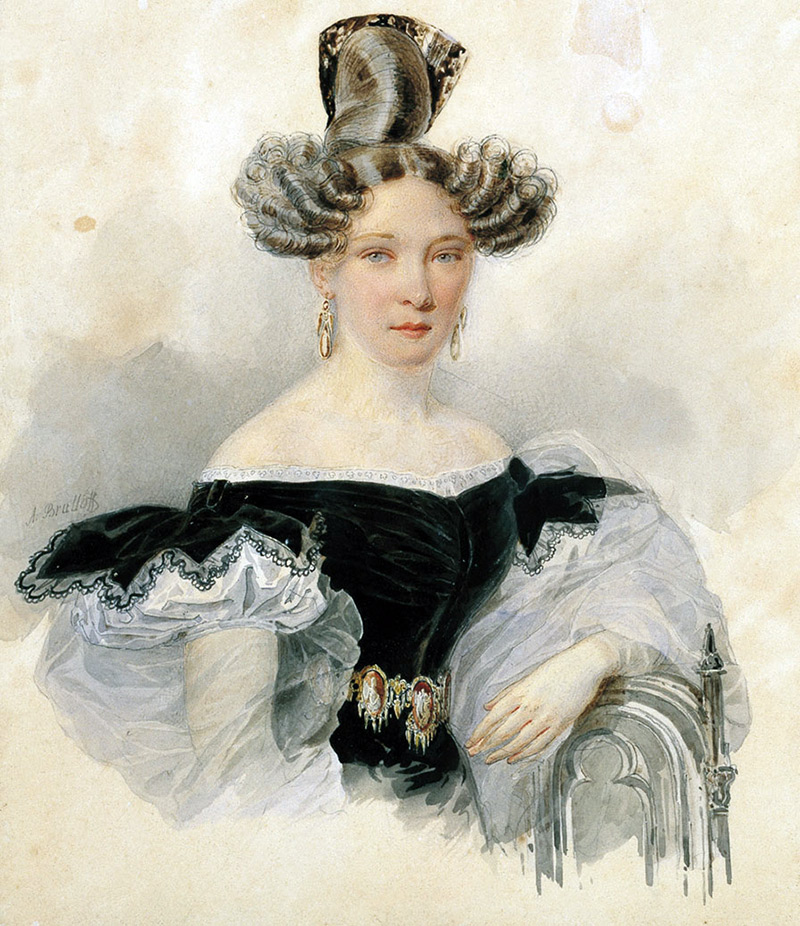
A.P. Bryullov. Portrait of Princess S.A. Lvov
Recall that the word "Biedermeier" meant the name of a non-existent person, or rather, a person who was only in literary satirical works. The word bieder, translated from German, means "honest, decent, simple-minded." By adding the two parts of the word, they got the name that they gave to the new satirical character.
German writers published their works about the life of local burghers, about their pastime, about the idea of a leisurely and comfortable life, using Biedermeier as the main character. And one of the German poets used the new name as his pseudonym. Soon the word Biedermeier became a household name. This word denoted the artistic trends of that time.
Fashion is becoming more accessible to all classes. But it is still dictated by France and England.
The time of Biedermeier fell in Russia during the reign of Emperors Alexander I and Nicholas I. These years were marked by numerous balls and splendid amusements. The balls were innumerable, and some gentlemen did not have the physical opportunity to attend all the balls held.
Balls united secular society and at the same time revived trade in the cities. Sewing workshops and fashion stores were delighted with these amusements, because a few days before the start of the celebration, the ladies who received the invitation sought to purchase stunning outfits in order to delight and admiration of all those present. Sometimes ballroom toilets were made by serf seamstresses, but more often they were ordered from milliners and tailors. Many items of clothing were bought in stores.
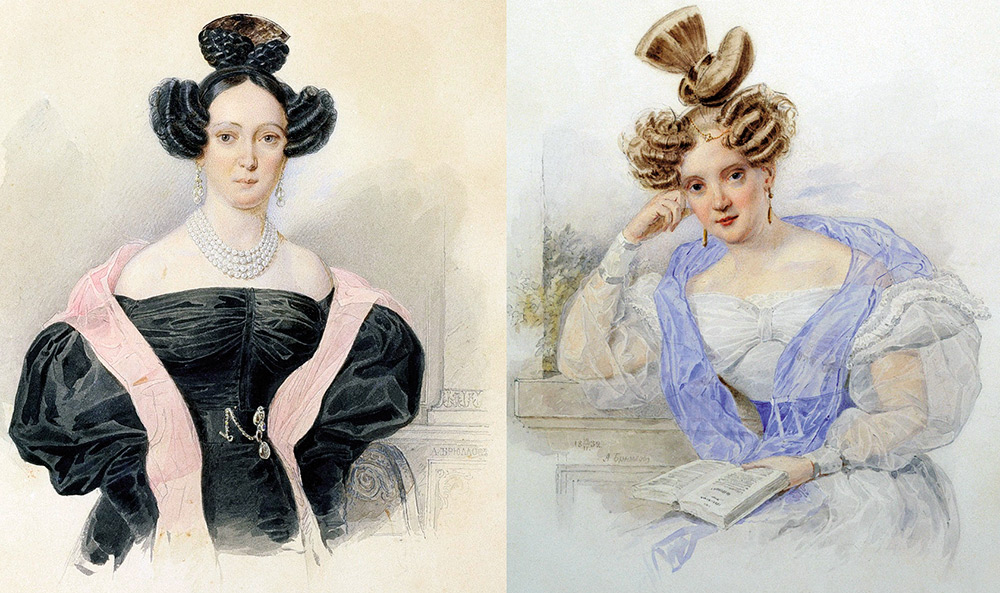
Alexander Pavlovich Bryullov - portraits
The best Moscow clothing, footwear and accessories stores are located on Kuznetsky Most, as well as on Tverskaya Street, Petrovka and in the streets and lanes adjacent to them.
In previous years, up to 1815, a dress without a waist prevailed, which, undoubtedly, was very impractical for both figure and health. These dresses took away from life at an early age many secular beauties, since the light fabric, under which, except for underwear, nothing else was supposed, could not warm the body. In the cold season, colds, or even tuberculosis, or consumption, as they called it then, were not uncommon diseases. From about 1815 to 1820, the waist began to return to its place - above the hips. In addition, they tried to highlight it even more with lacing, that is, the corset also re-established itself, however, somewhat in a softened form.
To make the waist look thin, they began to emphasize the size of the shoulders. For this, the sleeves were made wide, especially at the top, and narrowed towards the wrist. The skirt widened downward, forming large folds. By the way, the skirt was shortened so much that one could see not only the lady's shoes flashing under it, but also her ankles, which men dreamed of, looking with lust at the ball at the young beauty running by.
By 1835, the sleeve reaches unprecedented dimensions. Soon it will begin to shrink again, returning to simpler forms.The bodice will squeeze the lady's waist even tighter, and the skirt will lengthen, overgrown with many frills, and therefore look wider and more magnificent. At this time, the ladies adored expensive Kashmiri shawls, they threw them over their shoulders and back, covering their bare shoulders and neckline. These shawls have long been brought by the British from India.
There were fashionable robes and capes, which played the role of a cloak, like in medieval beauties. The coat, as such, was not in the ladies' wardrobe. In winter, ladies wore coat-like dresses made of thick woolen fabrics. If it was too cold, a shawl or wide capes, fur capes or stoles were worn over such a dress-coat. Fur boas were often used.
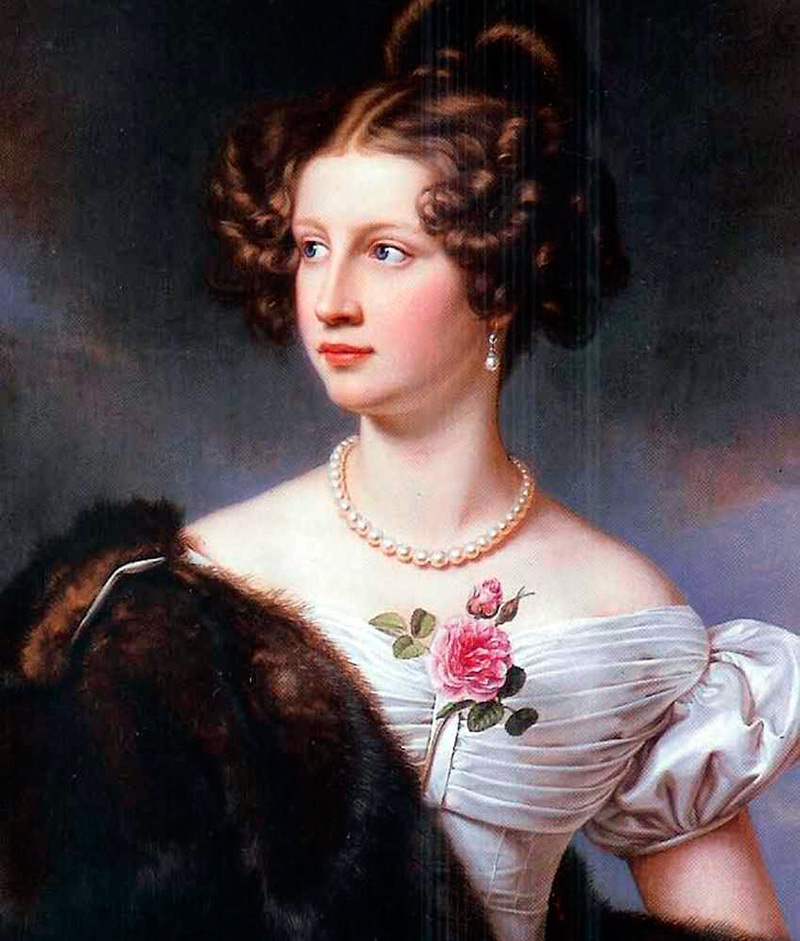
Baroness Amalia Krudener 1828 Portrait by Stieler
“I met you - and everything is old
In an obsolete heart revived;
I remembered the golden time -
And my heart felt so warm ... ”F.I. Tyutchev
In an obsolete heart revived;
I remembered the golden time -
And my heart felt so warm ... ”F.I. Tyutchev
In fashion, as in a mirror, the life of peoples is reflected - revolutions, victories, battles, political intrigues, lawsuits, theatrical and literary successes, salon gossip and scandals, scientific discoveries, etc.
Fabrics, garments and styles are named after famous actresses, singers and dancers. For example, the golden-beige fabric, which was popular in the 30s of the 19th century, was called creprashel, after the French tragic actress Rachelle. Or the celestial ethereal hat - Taglioni's hat - named after the dancer who danced like a marshmallow on stage and dressed like a spring cloud.
In honor of the incomparable Italian Taglioni, who was touring in St. Petersburg, were named hats, turbans, perfumes and even caramel. Talma - in France in the 19th century. a short man's cape that covers the shoulders and chest, and in Russia - a woman's long cape without sleeves - named after the French actor F. Talma.
At that time, checkered and striped fabrics, as well as fabrics with a light pattern, became very fashionable. Flowers on the fabric will be a little later.
The female Biedermeier hairstyle could be called a work of hairdressing. Hairdressers came to the lady at a certain time, and for a long, long time created fancy curls on her head. At the same time, they brought to their clients all the city gossip and behind-the-scenes secrets of the noble ladies of the capital.
On the female head, as a rule, hair was laid in the form of large curls or in the form of "cutlets" from braids on the temples. Gradually, playful curls were transformed into tight bunches or crowns of braids at the temples or on the crown. Long hair was pulled up and laid on the crown of the head in the form of curls or various hairpieces.
As adornments of hairstyles, there were certainly flowers, feathers, ribbons, lace, bows and bows and, of course, jewelry. The strongly open neck and deep cleavage made it possible to "highlight" the head, and therefore a complex hairstyle was of great importance.
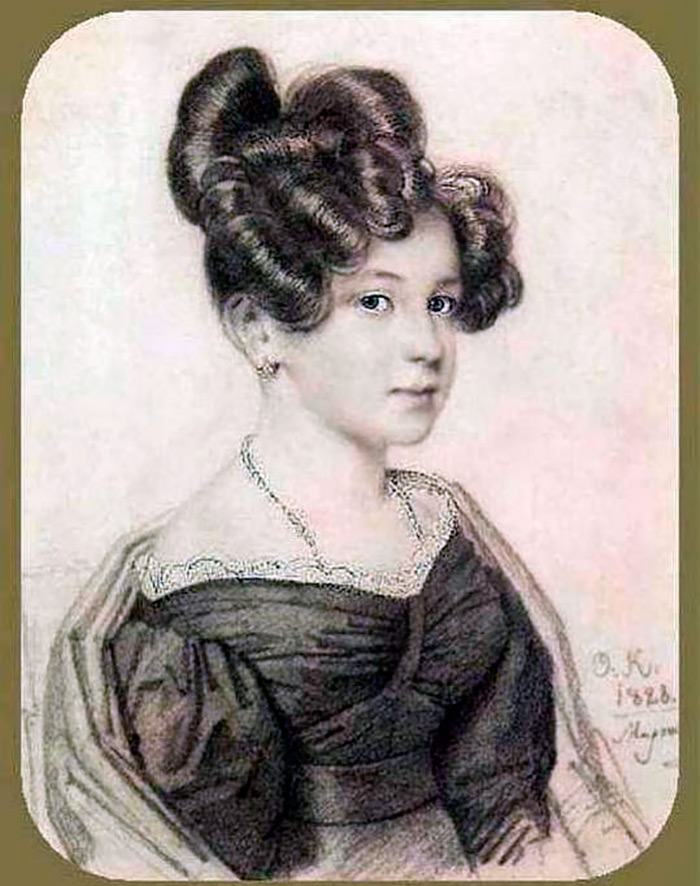
Orest Kiprensky. Portrait of Anna Olenina, 1828
I loved you, love still, maybe
In my soul it has not completely faded away,
But don't let it bother you anymore,
I do not want to sadden you with anything. A.S. Pushkin.
In my soul it has not completely faded away,
But don't let it bother you anymore,
I do not want to sadden you with anything. A.S. Pushkin.
Hats and shoes
Headdresses were of various types: bonnets, wide-brimmed hats, turbans, hoods. The caps were richly decorated along the edge with ruffles, lace or ribbons. Hats with huge brims were decorated with flowers and feathers. All the hats were tailored so as not to damage the lady's curls. Hats and hairstyles were literally completely covered with flowers, feathers, ribbons and flounces.
Most of the shoes in the ladies' wardrobe were without heels. They were flat, low shoes with ribbons. But already laced shoes appear, with small heels and a blunt toe. Shoes were made not only from leather, but also from silk fabrics. The lady's stockings on her legs were white, sometimes in pastel colors, and the linen was snow-white, embroidered with all kinds of embroidery in white satin stitch.
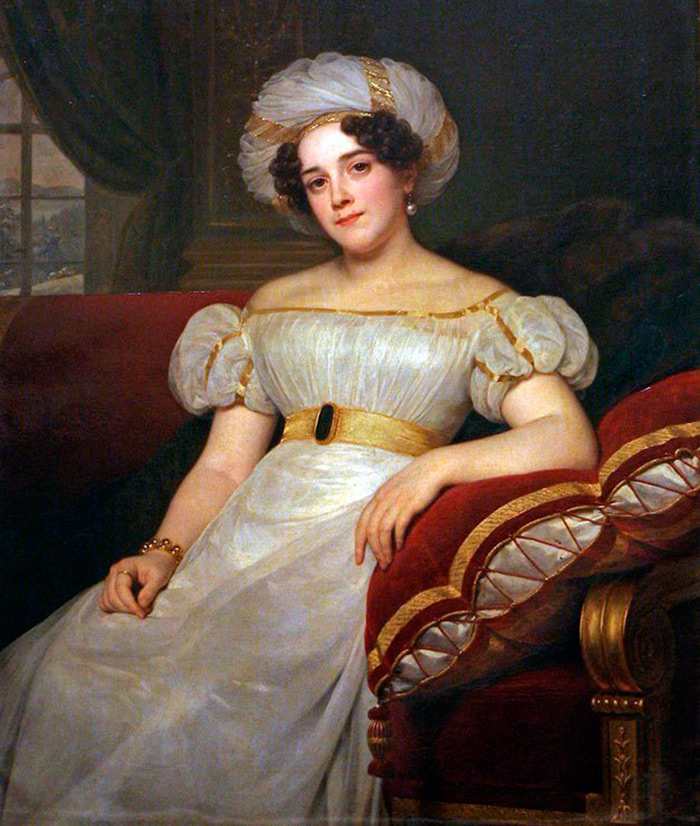
Portrait of N.S. Golitsyno L. Gersan
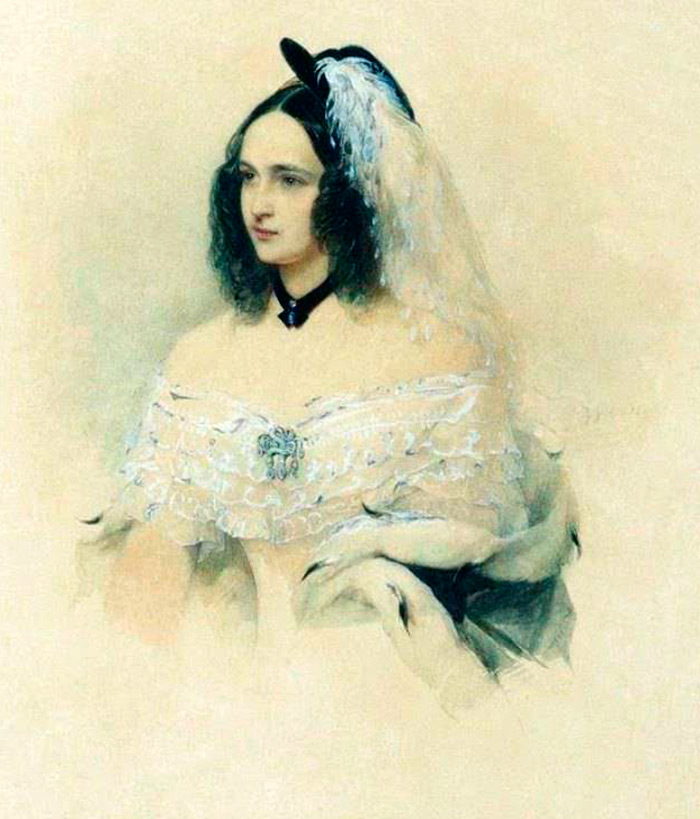
V.I. Gau. Portrait of N.N. Pushkina
Brooches, necklaces, bracelets, tiaras, combs, pins, long earrings, jewelry made from pearls and, of course, from precious stones were in fashion. At this time, the feronniere (decoration on the forehead) became very fashionable.
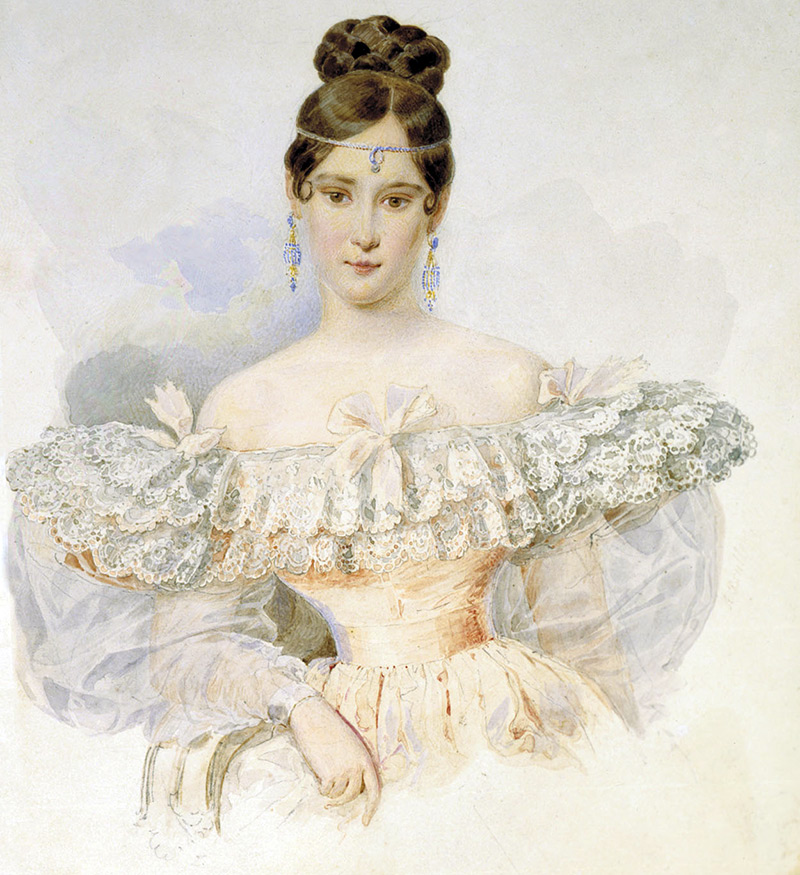
A.P. Bryullov. Portrait of Natalia Pushkina
And so, a lady with a thin waist, a slightly cropped fluffy skirt, with huge sleeves and carefully curled and laid curls at the temples is a characteristic embodiment of the Biedermeier style.
In ballroom fashion until 1823, the apmir style was kept, but over time it gave way to a new direction. Biedermeier became dominant in this area as well. The decoration of the dresses was intricate and extremely fancy, sometimes in one dress there were up to a dozen different bows and bows ... The ball gown was strongly lowered, it was sewn with a crinoline, and the best jewelry was worn.
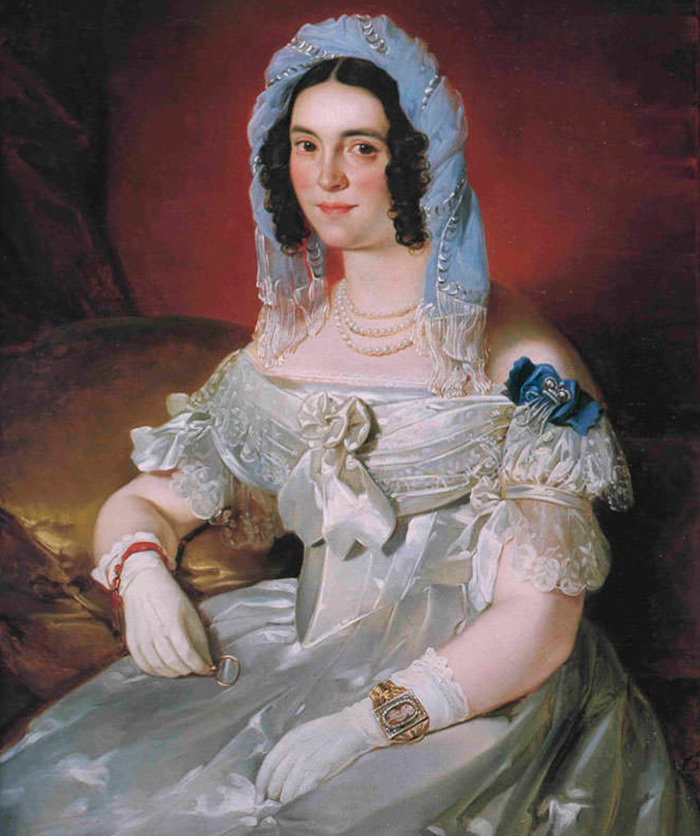
E.A. Plushir. Portrait of Countess Maria Alekseevna Olsufieva
At this time, a blouse appears as a new piece of clothing. During the day, the ladies changed clothes several times. Everything depended on the hour and location, as well as on the type of occupation. For example, home morning dress, walking dress, business dress, horse riding and carriage riding dress, visit dress, evening dress, ballroom dress, etc. The dress was accompanied by a hat, gloves, a fan and an umbrella.
In the makeup, in the first place was the whiteness of the lady's skin, and a slight blush. The makeup was subtle, pallor and fragility were appreciated. Fragility and elegance, romance and dreaminess - these are some of the characteristics of a woman of this era.
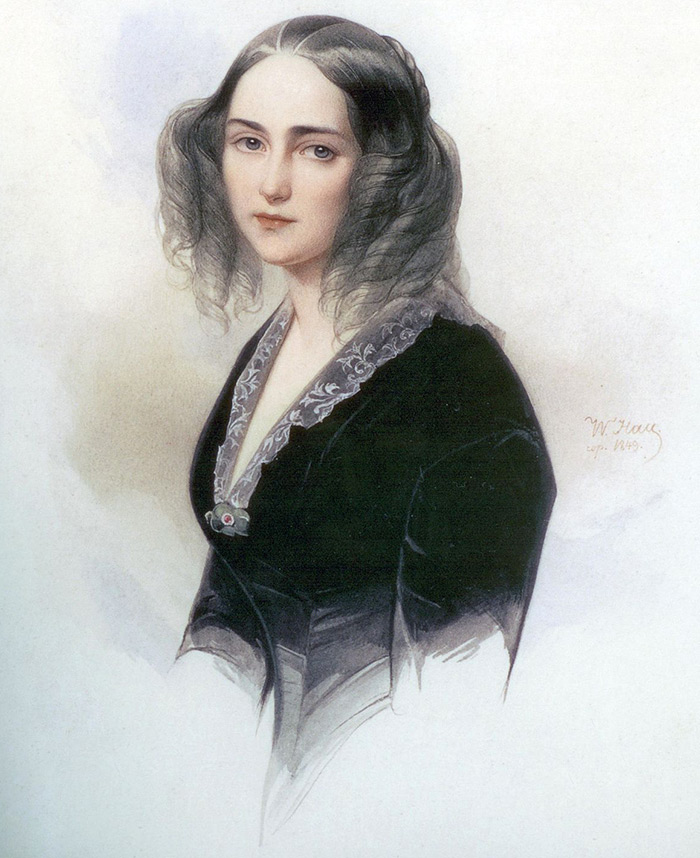
Portrait of Countess E.K. Musina-Pushkina. IN AND. Gau
Countess Emilia -
Whiter than a lily
Slimmer than her waist
In the world will not meet.
And the sky of Italy
It shines in her eyes
But Emilia's heart
Like the Bastille.
"NS. K. Musina-Pushkina "M.Yu. Lermontov
Whiter than a lily
Slimmer than her waist
In the world will not meet.
And the sky of Italy
It shines in her eyes
But Emilia's heart
Like the Bastille.
"NS. K. Musina-Pushkina "M.Yu. Lermontov
From this period, ladies began to be involved in active life. In the house of the most active and educated ladies of the secular society, it was established to organize their own literary and musical societies, in which one could learn the latest creative successes of writers, musicians and actors, as well as read or perform their own newly composed works.
These salons were the centers of the cultural life of Moscow or St. Petersburg. And very often the owner of such a salon herself was an extraordinary person who received an excellent education. For example, Zinaida Volkonskaya, in whose salon A.S. Pushkin, who dedicated a poem to her, E.A. Baratynsky, P.A. Vyazemsky, the young poet D.V. Venevitinov and many other cultural figures, known for her stage and musical talent, love of science and arts.
Queen of muses and beauty,
With a gentle hand you hold
Magic scepter of inspiration,
And over a brooding brow,
Double crowned wreath
And the genius curls and burns.
A.S. Pushkin, 1827
With a gentle hand you hold
Magic scepter of inspiration,
And over a brooding brow,
Double crowned wreath
And the genius curls and burns.
A.S. Pushkin, 1827
However, let us return to the literary hero Biedermeier, whose cheerful disposition so liked all readers of Europe. He turned out to be a sober and calculating rich man with a life acumen and a business mind. Therefore, the Biedermeier style has formed the person who, although he imitates the aristocrats, but his culture is dominated by well-being and comfort. Mr. Biedermeier knows how to count money so much that everything costs him less. That is why cheap imitations of expensive fabrics, furniture, interior items gradually began to come into fashion.
Secular beauties
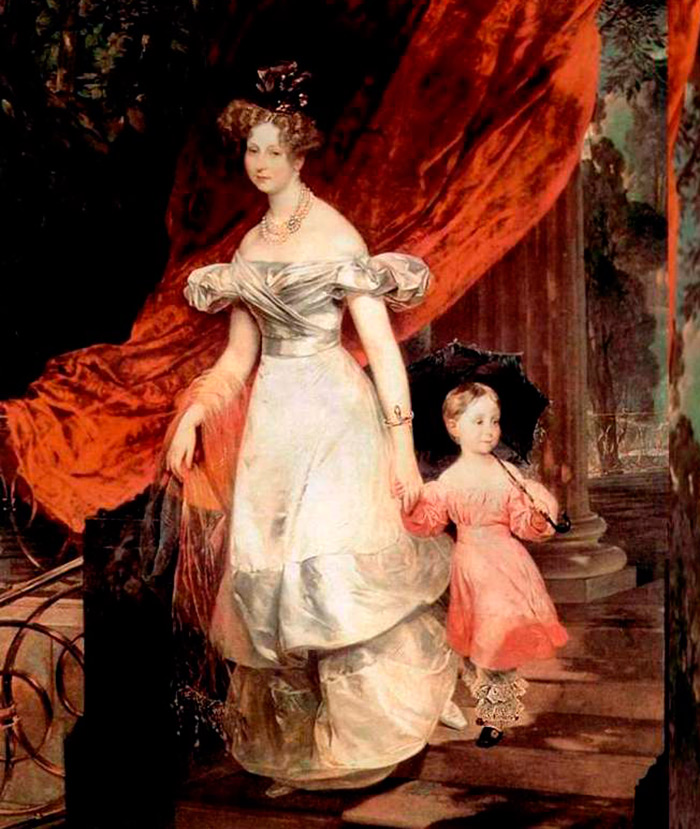
Portrait led. book Elena Pavlovna with her daughter.
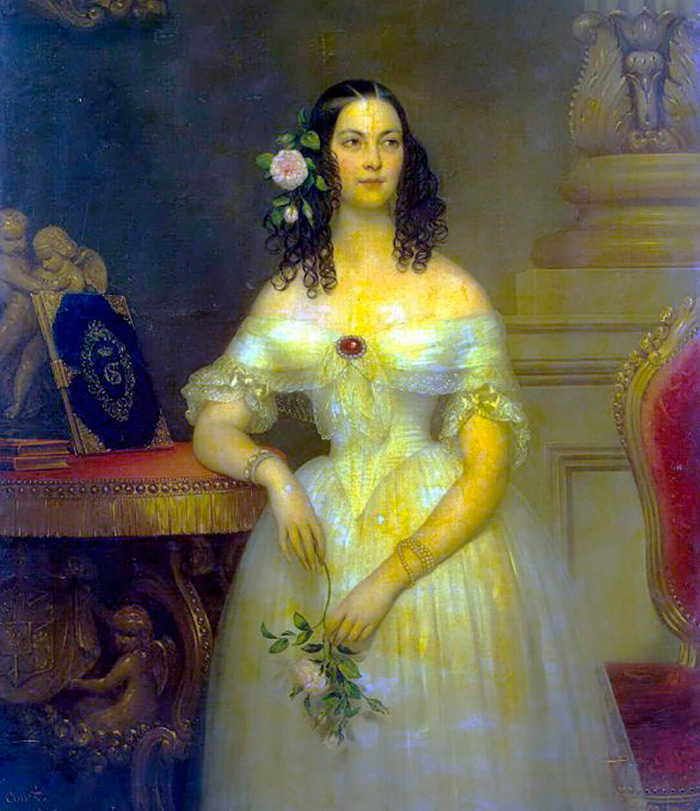
Joseph-Désiré Cours Portrait of Shcherbatova
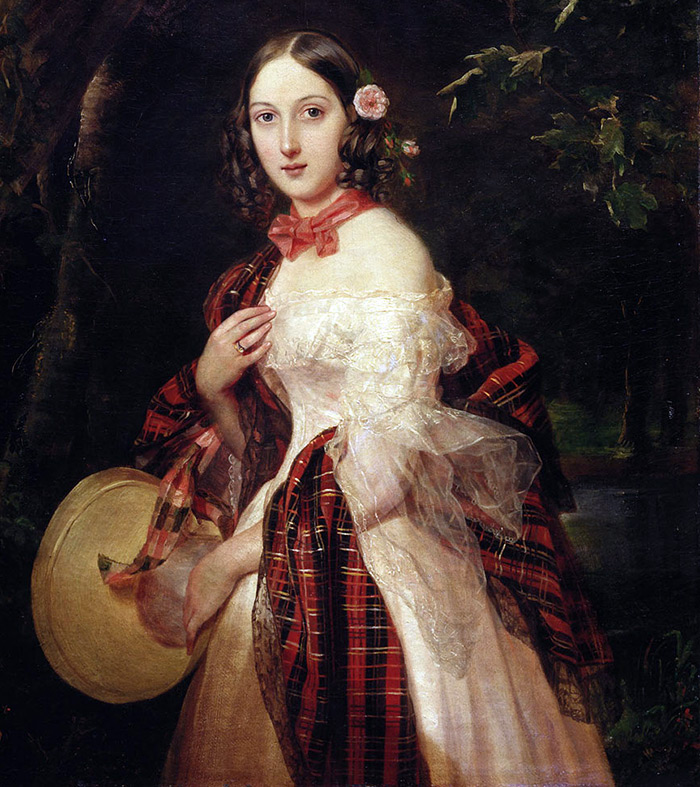
P. Orlov. Portrait of Maria Arkadyevna Beck
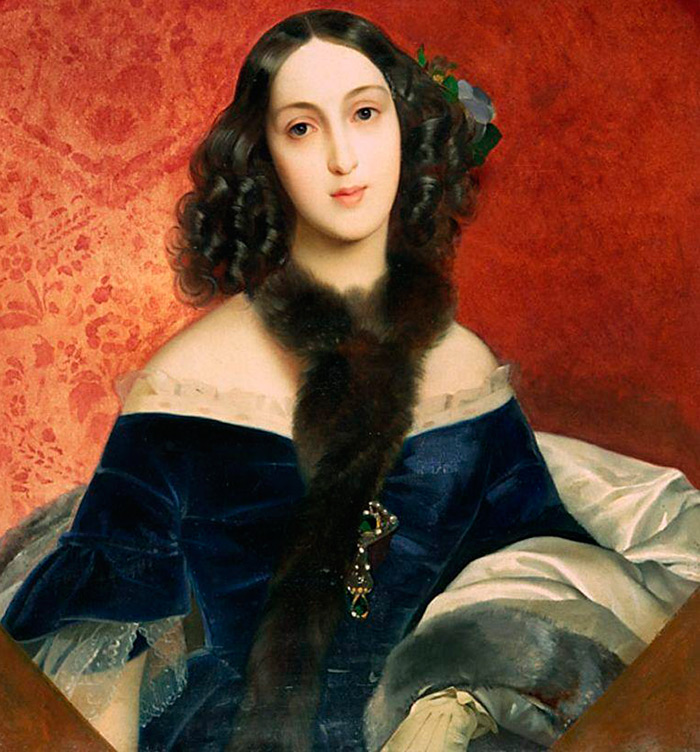
Karl Bryullov. Portrait of M.A. Beck
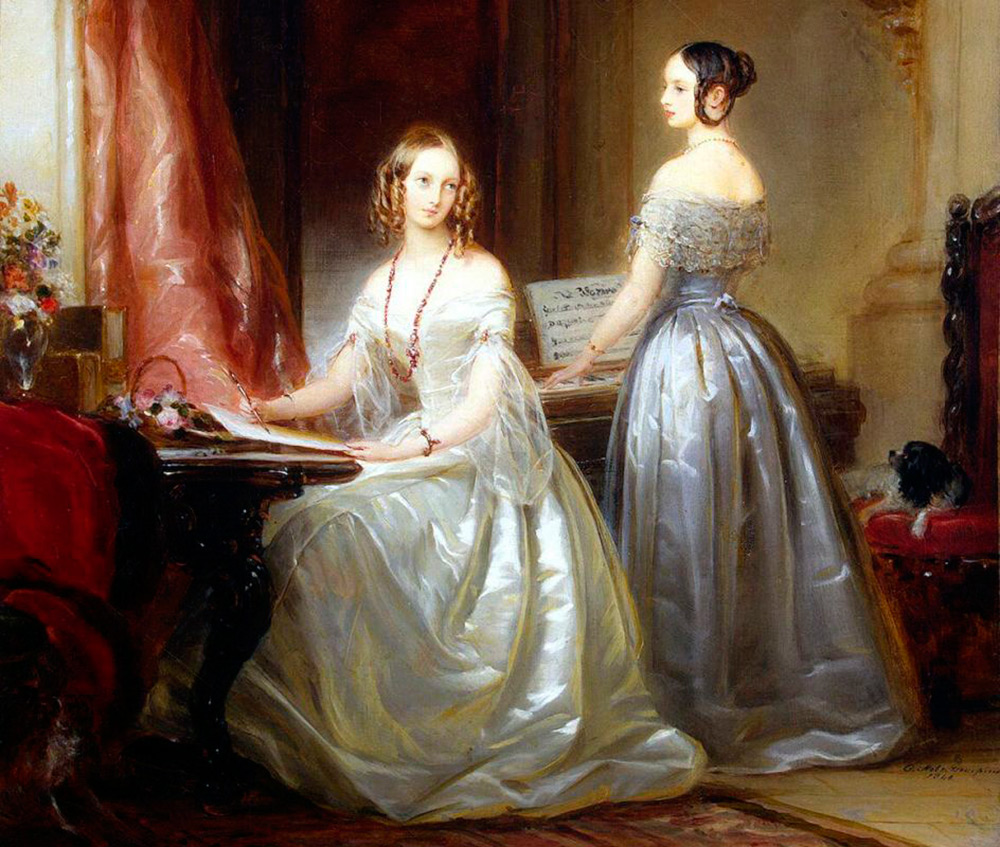
Christina Robertson. Portrait of the Grand Duchesses Olga Nikolaevna and Alexandra Nikolaevna at the harpsichord, 1840
A.P. Bryullov. Portrait of Natalia Viktorovna Stroganova, 1832
Comments and Reviews
Add a comment
Similar materials
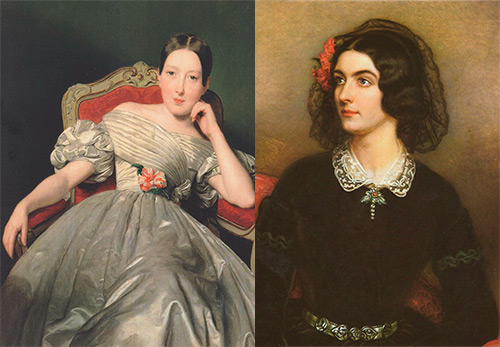 The history of the Biedermeier style in fashionable clothes
The history of the Biedermeier style in fashionable clothes
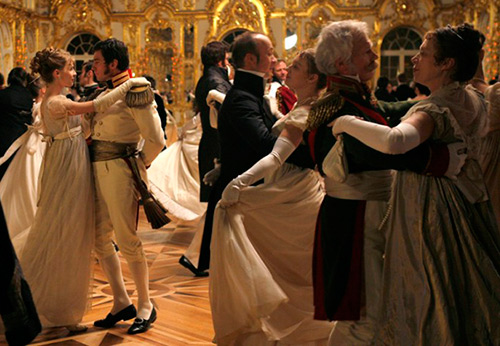 Empire style in 19th century clothing and Empire style dresses
Empire style in 19th century clothing and Empire style dresses
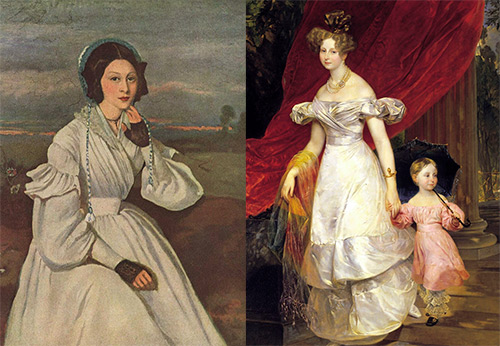 Fashion history and costume during the Romantic period
Fashion history and costume during the Romantic period
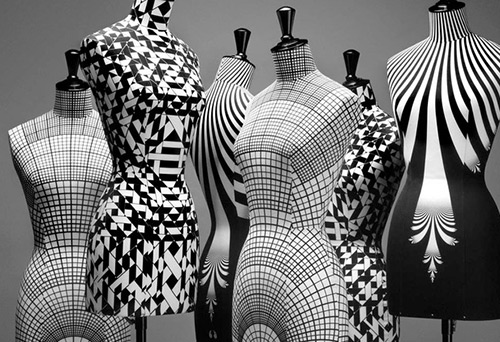 Fashion and fashion - the story of the origin of words
Fashion and fashion - the story of the origin of words
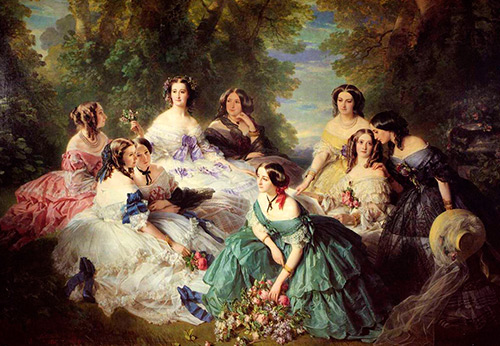 Second rococo costume - 19th century fashion
Second rococo costume - 19th century fashion
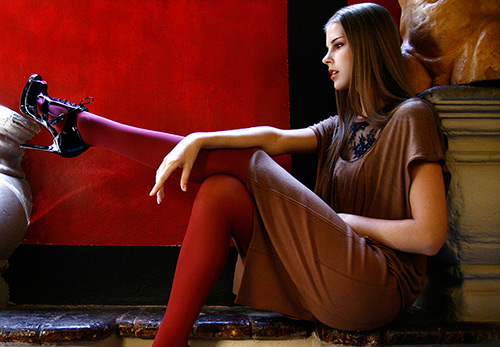 What you need to know about the most chic fashion looks
What you need to know about the most chic fashion looks
Rating news
Shades of clothing that make women look younger
What shades of hair make women younger: rules and photos
Funny wedding dresses - photos and ideas
12 most expensive down jackets for the winter
How to look 25 at 40: tips from supermodels
Beautiful schoolgirls
Anti-aging haircuts and hairstyles for women
Fashionable skirts for autumn and winter
Fashionable women's trousers for the cold season
Fashionable and stylish sandals for summer 2024
Spring-summer 2024
 Fashionable dresses and tops with thin spaghetti straps
Fashionable dresses and tops with thin spaghetti straps
 Bandana tops: how to wear stylishly and beautifully
Bandana tops: how to wear stylishly and beautifully
 How to put together the perfect men's wardrobe for the summer
How to put together the perfect men's wardrobe for the summer
 Trendy shorts for spring-summer 2024
Trendy shorts for spring-summer 2024
 Fashionable skirts for spring-summer 2024: a guide to online shopping
Fashionable skirts for spring-summer 2024: a guide to online shopping
 The most fashionable dresses spring-summer 2024: styles and colors
The most fashionable dresses spring-summer 2024: styles and colors
 Fashionable total look 2024: image ideas and trends
Fashionable total look 2024: image ideas and trends